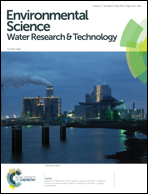Biofilm formation of anoxygenic photosynthetic bacteria induced by phototaxis for enhancing hydrogen production†
Abstract
In this study, the potential application of phototaxis to promote the formation of anoxygenic photosynthetic bacteria (APB) biofilms and hydrogen production was evaluated in batch and continuous experiments. The batch experiments showed that the amount of biofilm biomass on the illuminated sidewall reached 0.86 mg cm−2, which was 26-fold higher than that of the biofilm on the unlighted sidewall. The analyses of living cell fluorescence labeling and intracellular c-di-GMP suggested that sidewall illumination led to aggregation of APB cells to form flocs on the illuminated sidewall by upregulating intracellular c-di-GMP levels, but not on the illuminated liquid surface. These findings suggested that phototaxis and surface sensing modulated the biofilm formation of APB. Further, a continuous photorotating biological contactor reactor with mirror coating was developed to improve APB biofilm formation. APB biomass and hydrogen production was significantly higher than those in the control without mirror coating, indicating the feasibility of applying reflected light-induced biofilm formation of APB for improvement of hydrogen production.


 Please wait while we load your content...
Please wait while we load your content...